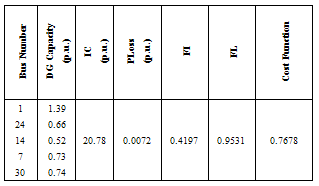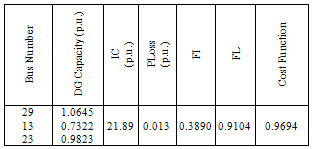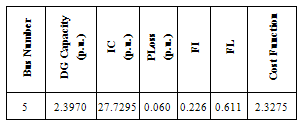-
Paper Information
- Next Paper
- Previous Paper
- Paper Submission
-
Journal Information
- About This Journal
- Editorial Board
- Current Issue
- Archive
- Author Guidelines
- Contact Us
Electrical and Electronic Engineering
p-ISSN: 2162-9455 e-ISSN: 2162-8459
2012; 2(2): 31-37
doi: 10.5923/j.eee.20120202.06
Applying BCO Algorithm to Solve the Optimal DG Placement and Sizing Problem
Mohammad Falahi Sohi , Morteza Shirdel
Islamic Azad University
Correspondence to: Mohammad Falahi Sohi , Islamic Azad University.
| Email: |  |
Copyright © 2012 Scientific & Academic Publishing. All Rights Reserved.
In this paper, the problem of DG placement and sizing for loss reduction and line capacity improvement has been considered and evaluated. In order to solve the optimization problem, authors are using the novel and heuristic BCO algorithm. This algorithm is inspired of the intelligent behaviour of bees during the nectar search process. Finally, the results of applying the Bee Colony Optimization algorithm for DG placement and sizing in IEEE 33 nodes test network are shown.
Keywords: Bee Colony Optimization, Placement, Distributed Generation, Loss Reduction, Line Capacity Improvement
Article Outline
1. Introduction
- Acording to the continuous growth of restructuring in distribution system, the issue of using distributed generation resources (DGs)– due to advantages such as distribution loss reduction, line capacity and voltage profile improvement, increasing the reliability,environmentally friendly and etc.–hasbeen considered severely. But despite the afore mentioned benefits, the incorrect selection of location, number and/or capacity of DG lead to rise of network problems.Therefore,to reach optimal operation of distribution network, optimal DG placement and sizing isessential[1-4],[30].To meet this goal, the parameters such as losses, line capacity, voltage profile and reliability should be evaluated in all states before and after the DG installation, and the best solution should be selected. But due to the complexity andtime consuming, authors are using the bee colony optimization algorithm inspired by bees’ intelligent behaviour in nature for nectar search, to solve this problem. According to high importance degree of losses in Iran (more than 20%) the loss and line capacity indexes will be considered.
1.1. Literature Review
- With the daily growth ofusing DGs in distributed networks, optimal positioning of these resources by considering different objectives such as loss reduction, the voltage profile improvement , etc. has been solved by different methods such as GA, PSO, CPSO, ACO, etc.A summary of carried out activities in this field can be seen in table 1.Some of the innovations discussed in this Paper are solving the problem by the BCO novel method, reaching very high flexibility in produced program, and determination of the DG capacity floatingly.
2. Introducing the Indexes for DG Placement and Determining the Objective Function
2.1. Loss Reduction Index
- In terms of heavy loads, transmission and distribution lines have a double significance because in such a condition a penaltyas energy with higher price ordisadvantage will be inflicted to the consumer or distribution company, respectively. These losses are caused by power transmission through the lines with resistance. Therefore by means of DGs, we can reduce the amount of transmitted power and in this way the losses will be reduced consequently.[1-4, 26, 32-33]The loss in distribution network is calculated by the following formula:
 | (1) |
 | (2) |
 | (3) |
 | (4) |
 | (5) |
 | (6) |
2.2. Index ofLine's Free Capacity
- Another benefit of using DG is to reduce the transmitted power through lines. This increases the free capacity of lines and therefore prevents from establishment of new lines, substations and etc.[1-4, 26-33]With calculating the current flows through the lines, before and after the installation of DGs and comparing thenetworkflow in these two states, another component of the objective function will be built.
 | (7) |
 | (8) |
 | (9) |
2.3. Determination of theObjective Functions
- By considering both indexes, loss reduction and increasing the free capacity of the lines, the objective function will be considered as follow:
 | (10) |
 | (11) |
 | (12) |
 | (13) |
2.4. DG Modelling
- Generally the operational DG models in distribution networksare divided into two categories:PV modelPQ modelIn this paper, authorsassume that, all DGs are modelled as PQ.[2, 4]
3. Bee Colony Optimization Algorithm (BCO)
- Social insects (bees, wasps, ants, termites)have been living on the Earth for millions of years, building nests and more complex dwellings, organizing production and procuring food. The colonies of social insects are very flexible and can adapt well to the environment changes. This flexibility allows the colony of social insects to be robust and to maintain its life against considerable disturbances.The dynamism of the social insect population is a result of the different actions and interactions of individual insects with each other, as well as with their environment. The interactions are executed via multitude of various chemical and/or physical signals. The final product of different actions and interactions represents the behaviourof asocial insect colony. The examples of such interactive behaviour are dancing of bees during the food procurement, ants' pheromone secretion, and performance of specific acts, which signal the other insects to start the same actions. These communication systems between individual insects contribute to the formation of the "collective intelligence" of the social insect colonies. In spite of the existence of a large number of different social insect species, and variation in their behavioural patterns, it is possible to describe individual insects as species capable of performing a variety of complex tasks. The best example is the collection and processing of nectar, the practice of which is highly organized[5, 34-37].Each bee decides to reach the nectar source by followinganest mate who has already discovered a patch of flowers. Each hive has a so-called dance floor area in which the bees which have discovered nectar sources dance, in that way trying to convince their nest mates to follow them. If a bee decides to leave the hive to get nectar, she follows one of the dancer bees to one of the nectar areas. Upon arrival, the foraging bee takes a load of nectar and returns to the hive relinquishing the nectar to a food storer bee[5].After she relinquishes the food, the bee can (a) abandon the food source and become again an uncommitted follower, (b) continue to forage at the food source without recruiting the nest mates, or (c) dance and thus recruit the nest mates before returning to the food source. The bee opts for one of the above alternatives with a certain probability. Within the dance area, the dancer bees “advertise” different food areas. The mechanisms by which the bee decides to follow a specific dancer are not well understood, but it is considered that “the recruitment among bees is always a function of the quality of the food source”. The artificial bee colony behaves partially alike, and partially different from bee colonies in nature. Within the Bee Colony Optimization Metaheuristic (BCO), agents that we call artificial bees collaborate in order to solve difficult combinatorial optimization problem. All artificial bees are located in the hive at the beginning of the search process. During the search process, artificial bees communicate directly. Each artificial bee makes a series of local moves, and in this way incrementally constructs a solution of the problem. Bees add solution components to the current partial solution until they create one or more feasible solutions. The search process is composed of iterations. Flying through the space, our artificial bees perform forward pass or backward pass. During forward pass, bees create various partial solutions. They do this via a combination of individual exploration and collective experience from the past. After that, they perform backward pass, i.e. they return to the hive. In the hive, all bees participate in a decision-making process. We assume that every bee can obtain the information about solutions' quality generated by all other bees. In this way, bees exchange information about quality of the partial solutions created. Bees compare all generated partial solutions. Based on the quality of the partial solutions generated, every bee decides whether to abandon the created partial solution and become again an uncommitted follower, continue to expand the same partial solution without recruiting the nest mates, or dance and thus recruit the nest mates before returning to the created partial solution. Depending on the quality of the partial solutions generated, every bee possesses certain level of loyalty to the path leading to the previously discovered partial solution. During the second forward pass, bees expand previously-created partial solutions, and after that perform again the backward pass and return to the hive. In the hive bees again participate in a decision-making process, perform third forward pass, etc. The iteration ends when one or more feasible solutions are created[5, 34-36, 39-40]. The algorithm parameters whose values need to be set prior the algorithm execution are as follows:nPop- The number of bees in the hivenMove- The number of constructive moves during one forward passIn the beginning of the search, all the bees are in the hive. The following is the pseudo code of the BCO algorithm[5]:1.Initialization: every bee is set to an empty solution;2.For every bee,Do the forward pass:a) Set k = 1; //counter for constructive moves in the forward pass;b) Evaluate all possible constructive moves;c) According to evaluation, choose one move, using the roulette wheel;d) k= k + 1; If k ≤ nMoveGo To step b.3.All bees are back to the hive; // backward pass starts;4.Sort the bees by their objective function value;5.Every bee decides randomly whether to continue its own exploration and become a recruiter, or to become a follower (bees with higher objective function value have greater chance to continue their own exploration);6.For every follower, choose a new solution from recruiters by the roulette wheel;7.If the stopping condition is not met Go To step 2;8.Output the best result.The stopping condition could be the maximum number of forward/backward passes or the maximum number of forward/backward passes, without improving the objective function[5, 36-40]. In the next chapter, we are trying to apply the BCO algorithm into the optimal DG placement and sizing problem.
4. Applying BCO Algorithm to the Optimal DG Placement and Sizing Problem
- In this chapter, the issue ofoptimal distributed generation sources allocation for sample 33 nodes IEEE net work will besolved by the BCO based on assumptions that are to be discussed more, and the concepts which are raisedin thechapter 3, andthe considered objective function.The Pseudocode of the solving program which is written in MATLAB isas follows:1. Start: get the network information.2. Performload-flowand save network data.3. Determinethe number ofbees (nPop), the number of constructive moves in each forward pass (nMove), and the maximum number of iterations, and determine the number of installable DGs.4. Generateinitial population.5. Forward pass:a. set k=1b. Choose one of the constructive moves by means of random Switch.c. k=k+1, if k≥nMovethen go to b6. Returnallthe bees to the hive (Backward pass).7. Sort the bees (selected solutions) based ontheir objective function value and save the best result.Based on the objective function value, each bee decides:to leave its solution and to follow another bee, develops its solution without recruiting othernest mates, and or recruit othernest mates and develop its solution with them.8. Foreach ofthe followerbees, allocate a bee to be followed, using roulette wheel. (A bee with the higher objective function value has higher chance to be followed) 9. Check the stopping condition(maximum iteration), if it is not met, go to 5.10. Output: the best solution; End.
5. Numerical Studies and Results
- Before Viewing the results,consider the following assumptions: In the bus connected to the mainpower(Slack bus), one couldn't install any DG, and this problem could be solved for anynumber of authorized distributed generators, but the authors solved the problem for 5, 3, and 1 DGs. they also assume that the minimum available DG capacity is 500 kVA,maximum available DG capacity is 3500kVA, and in this range, the DG capacity is chosen by the program asfloat. These sources are also used in unit power factor, exclusively active power production.The solving algorithmis flexiblein such a manner that any network data could beeasily input, and the parameters such as DG number and power range, number of bees and iterations could be changed. In this example, the basic voltage has been considered 10.5 kV and the basic power was 1 MVA. The number of bees was 100, and the number of Iterations has been considered 200. Also the number of constructive moves in each forward pass was assumed 1 which has two components that are selected randomly:a). DG location changingb). DG power changingAlso in objective function, the value of w1 is 1, and w2 is 4. The results can be seen in the following tables and figures.In figures 1, 2 and 3The horizontal axis shows the number of the iteration times of searching in once run of the program. In the first graph, the vertical axis shows the amount of the main cost function. In the second graph the occupied capacity amount of lines is shown and in the third graph we see the losses amount of lines.
|
|
|
|
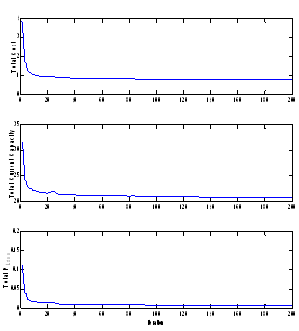 | Figure 1. The results of the program running for installation of 5 DGs, using 100 bees, and 200 iterations |
 | Figure 2. The results of the program running for installation of3 DGs, using 100 bees, and 200 iterations |
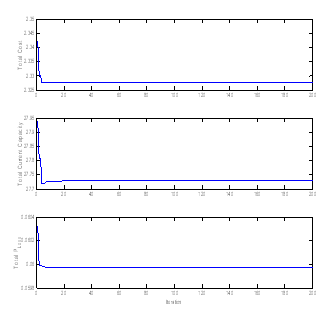 | Figure 3. The results of the program running for installation of1 DG, using 100 bees, and 200 iterations |
6. Conclusions
- Inthis research, the problem of determining the optimal position, numbers, and capacity of distributed generators, was studied. Initially the background of this problem was reviewed, and the necessity to do further research with different objectives and attitudes about this issue was explained. Regarding the development process inIslamic Republic of Iran and consequently the restructuring of industry and electricity market, a careful study onoptimalDG allocation with different aim sand methods is essential, in order to prevent waste of capital and other considerations. Due to the high rate of distribution losses in Islamic Republic of Iran, (which isover20%), authors chose this index along with the amount of free line's capacity index as their optimization objectives. Then the forward-backward sweep power flow was introduced and coded. The primary objective in this paper was presenting Bee Colony Optimization (BCO) algorithm asa newand efficient method to solve optimization problems, and especially theproblem of optimal DG allocation. BCO results show that this method has a good convergence, and each time the program was run, a same output was received.
References
| [1] | M.A.Niakey, M. A. Golkar, and M. R. Haghifam, "Optimal DG Placement to ReduceLossesandImproveVoltage ProfileinDistribution Networks", MSc thesis, Islamic Azad University, South Tehran, September 2009. |
| [2] | N. Khalesi, M. R. Haghifam, and M. Lesani, "UsingDynamicProgramming for DG Placement in Distribution Networks with Time-Varying Loads to ReduceLossesandIncreaseReliability", MSc thesis, Islamic Azad University, South Tehran, September 2009. |
| [3] | A. Hadian,M. R. Haghifam, "Risk Management in Distributed Generators Placement and Sizing", MSc thesis, Islamic Azad University, South Tehran, August 2009. |
| [4] | P. Alemi, G. Gharepetian, M. Abedi, "Optimal DG Positioning with respect toNetwork SecurityCriteria", MSc thesis, Islamic Azad University, Science and Research 2008. |
| [5] | CheePeng Lim, Lakhmi C. Jain, and SatchidanandaDehuri (Eds.), “Innovations in Swarm Intelligence”, 2009 Springer-Verlag Berlin Heidelberg, Chapter 3. |
| [6] | C.L.T. Borges, and D.M. Falcao, “Impact of Distributed Generation Allocation and Sizing on Reliability, Losses, and Voltage Profile”, 2003 IEEE Bologna Power Tech Conference Proceedings, Bologna, vol.2, 23-26 June 2003. |
| [7] | D. Zhu, R. P. Broadwater, K.S Tam, R. Seguin and H. Asgeirsson, "Impact of DG Placement on Reliability and Efficiency with Time-Varying Loads", IEEE Transaction on Power System, Vol. 21, No. 1, February 2006. |
| [8] | C. Wang, and M.H. Nehrir, “Analitical approaches for optimal placement of distributed generation sources in power systems” IEEE Transactions on Power Systems, vol.19, No.4, Nov. 2004, pp. 2068-2076. |
| [9] | T. Gozel, M. H. HOCAOGLO, U. Eminoglu, A. Balikci, “Optimal Placement and Sizing of Distributed Generation on Radial Feeder with Different Static Load Models” IEEE International Conference, 18 Nov 2005. |
| [10] | W. El-Khattam, Y. Hegazi and M. M. Salama, ”An Integrated Distributed Generation Optimization Model for Distribution System Planning” IEEE Transactions on Power Systems, vol.20, No.2, May 2005, pp. 1158-1165. |
| [11] | G. Harrison and A. Wallace, “Optimal power flow evaluation of distribution network capacity for the connection of distributed generation” IEE Proc, Gener. Transm. Distrib. 2005, 152, (1), pp. 115-122. |
| [12] | D.H. Popovic, J.A. Greatbanks, M. Begovic, “Placement of distributed generators and reclosers for distribution network security and reliability”, Int. J. power Energy System, 2005, 27, (5-6), pp.398-408. |
| [13] | J. A. Greatbanks, D. H. Popovic, M. Begovic, A. Pregelj and T. C. Green, “Optimization for Security and Reliability of Power Systems with Distributed Generation” 2003 IEEE Bologna Power Tech Conference Proceedings, Bologna, vol.1, 23-26 June 2003. |
| [14] | G. Celli, E. Ghiani, S. Mocci, and F. Pillo, “A Multi-Objective Formulation for the Optimal Sizing and Sitting of Embedded Generation in Distribution Networks”, 2003 IEEE Bologna Power Tech Conference Proceedings, Bologna, vol.1, 23-26 June 2003. |
| [15] | M.R. Haghifam, H. Falaghiand O.P. Malik, “Risk-Based distributed generation placement” IET Gener. Transm. Distrib., 2008, pp. 252-260. |
| [16] | Borges, C.L.T., and Falcao, D.M. “Optimal distributed generation allocation for reliability, losses, and voltage improvement”, Int.J.Power Energy Syst., 2006, 28, (6),pp. 413-420. |
| [17] | Teng, J.-H., Luor, T.-S., and Liu, Y.-H.: “Strategic distributed generator placements for service reliability improvement”. Proc. IEEE Power Engineering Society Summer Meeting, Chicago, USA, 21-22 July 2002, pp. 719-724. |
| [18] | B. Kuri, M. A. Redfern, and F. Li, “Optimization of rating and positioning of dispersed generation with minimum network disruption” 2004 IEEE power Engineering Society General Meeting, vol.2, 6-10 June 2004, pp. 2074-2078. |
| [19] | X. Tang and G. Tang, “Multi-objective Planning for Distributed Generation in Distribution Network” DRPT 2008, Third international conference, 6-9 April 2008 Nanjing China. |
| [20] | G. Carpinelli, G. Celli, S. Mocci, “Optimization of embedded generation sizing and sitting by using a double trade-off method”, IEE Proc, Gener. Transm. Distrib. 2005, 152, (4), pp. 503-513. |
| [21] | M. Gandomkar, M. Vakilian, and M. Ehsan, “A Combination of Genetic Algorithm and Simulated Annealing for Optimal DG Allocation in Distribution networks” 2005 Canadian Conference on Electrical and Computer Engineering, 1-4 May 2005, Page: 645-648. |
| [22] | Edwin B. Cano, “Utilizing Fuzzy Optimization for Distributed Generation ALLocation” IEEE region 10 Conference, TENCON 2007, 30 Oct 2007. |
| [23] | K.-H. Kim, Y.-J. Lee, S.-B. Rhee, S.-K. Lee and S.-K. You, “Dispersed generator placement using fuzzy-GA in distribution systems” In Proc. 2002 IEEE Power Engineering Society. Summer Meeting, vol.3, Chicago, IL, July 2002, pp. 1148-1153. |
| [24] | M. Sebastian Rios, S. Marcelo Rubio, “Sequential Optimization for Sitting and Sizing Distributed Generation (DG) in Medium Voltage (MV) Distribution Networks” IEEE PowerbTech Conferences, 2007. |
| [25] | K. Nara, Y. Hayashi, K. Ikeda, and T. Ashizawa, “Application of tabu search to optimal placement of distributed generators” IEEE Power Engineering Siciety Winter Meeting, pp. 918-923, 2001. |
| [26] | G. Celli, and F. Pillo, “Optimal distributed generation allocation in MV distribution networks” Proceeding of the IEEE International Conference on Power Engineering Society, May, 2001, pp. 81-86. |
| [27] | C. Tautiva, A. Cadena, “Optimal Placement of Distributed Generation on Distribution Networks” IEEE PES-Transmission and Distribution conference and exposition, Latin America, 13-15 Aug 2008. |
| [28] | P. Chiradega , “Benefit of Distributed Generation: A Line Loss Reduction Analysis” 2005 IEEE/PES Transmission and Distribution Conference & Exhibition: Asia and Pacific Dalian, China. |
| [29] | D.T. Le, M.A. Kashem, M. Negnevitsky, and G. Ledwich, “Optimal Distributed Generation Parameters for Reducing Losses with Economic Concideration” IEEE General meeting 24-28 June 2007, Page: 1-8. |
| [30] | Rau, N.S., and Wan, Y.-H.: “Optimum location of resources in distributed planning” IEEE Trans. Power Syst., 1994, vol.4, pp. 2014-2020. |
| [31] | A. Keane and M. o. Malley, “Optimal Allocation of Embedded Generation on Distribution Networks” IEEE Transactions on Power Systems, vol.20, No.3, 2005, pp. 1640-1646. |
| [32] | H. Falaghi, M. R. Haghifam, “ACO Algorithm for distributed generation source allocation and sizing in distribution systems” IEEE Power Tech Conference, 1-5 July 2007, pp. 555-560. |
| [33] | A. Katid, D. Skrlec, “Optimization of Distributed Generation in the MV Networks” EUROCON Conferences, Ljubljana, Slovenia, vol.1, 22-24 Sept 2003, Page; 509-512. |
| [34] | Lučić, P., Teodorović, D.: Bee system: modeling combinatorial optimization transportation engineering problems by swarm intelligence. In: Preprints of the TRISTANIV Triennial Symposium on Transportation Analysis, Sao Miguel, Azores Islands,Portugal, pp. 441–445 (2001). |
| [35] | Lučić, P., Teodorović, D.: Transportation modeling: an artificial life approach. In:Proceedings of the 14th IEEE International Conference on Tools with ArtificialIntelligence, Washington, DC, pp. 216–223 (2002). |
| [36] | Lučić, P., Teodorović, D.: Computing with bees: attacking complex transportationengineering problems. Int. J. Artif. Intell. T. 12, 375–394 (2003a). |
| [37] | Teodorović, D.: Transport Modeling by Multi-Agent Systems: A Swarm IntelligenceApproach. Transport. Plan. Techn. 26, 289–312 (2003b). |
| [38] | Teodorović, D., Dell’Orco, M.: Bee colony optimization – a cooperative learningapproach to complex transportation problems. In: Advanced OR and AI Methods inTransportation. Proceedings of the 10th Meeting of the EURO Working Group onTransportation, Poznan, Poland, pp. 51–60 (2005) |
| [39] | Baykasoglu, A., Özbakýr, L., Tapkan, P.: Artificial Bee Colony Algorithm and ItsApplication to Generalized Assignment Problem. In: Chan, F.T.S., Tiwari, M.K. (eds.)Swarm Intelligence: Focus on Ant and Particle Swarm Optimization, pp. 113–143. ItechEducation and Publishing, Vienna (2007). |
| [40] | Quijano, N., Passino, K.M.: Honey Bee Social Foraging Algorithms for ResourceAllocation, Part II: Application. In: Proceedings of the 2007 American Control Conference, New York, pp. 3389–3394 (2007b). |
 Abstract
Abstract Reference
Reference Full-Text PDF
Full-Text PDF Full-Text HTML
Full-Text HTML
